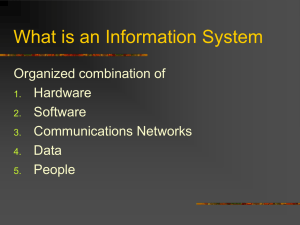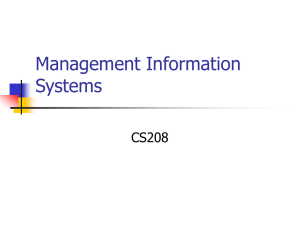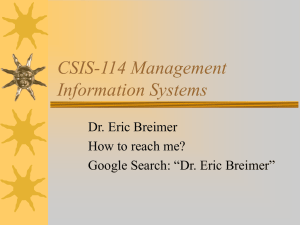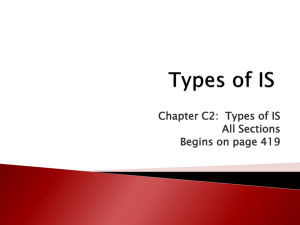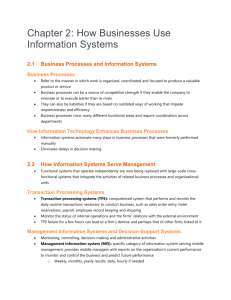Business-related Information Systems
advertisement
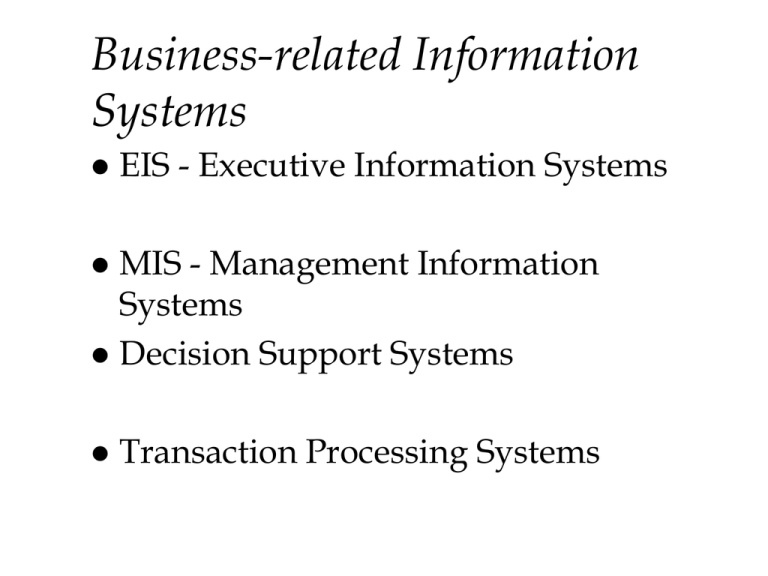
Business-related Information Systems EIS - Executive Information Systems MIS - Management Information Systems Decision Support Systems Transaction Processing Systems Transaction Processing Systems The lowest level of information system Used by businesses to record “transaction” information Transactions include things like booking airline tickets, purchasing goods or services Management Information Systems A step up from TPS This type of systems is used for routine reporting Reports are used to monitor and control normal business activities Decision Support Systems Similar in some ways to MIS Used to solve unusual problems, and problems that fall outside the capabilities of the MIS Executive Information Systems The King of the Hill!! (Topmost systems) High-level systems designed to provide Senior Management with information on general trends in business activities rather than the intimate details Used to help S.M.. formulate business strategies, and plan for the future Characteristics of decisions and information needs when ascending the diferent business levels. Less structured problems and decisions Greater need for summarised information Greater need for external information Longer time horizion Transaction Processing Systems The lowest level of Business system Provides raw data used in processing in EIS, MIS and DSS TPS are important for a business. They manage the data that keeps the business going, e.g. Airline ticket bookings, etc. Transaction Processing Systems (cont’d) TPS accept input related to a transaction event, process it, and produce output The primary users of a TPS are staff at the Operational, or lowest-level, of a business Structure of a typcial TPS On-line data entry Transaction files Keypunched cards Scanning devices INPUTS Transaction Processing System - Record - Merge - Perform - Sort - List - Update Products Documents TPS Data for other systems OUTPUTS What is a Management Information System? A MIS provides Managers with reports on an organisations performance - both past and present. MIS server Managers by helping them monitor actual business performance, and predict future performance. General Properties of a MIS? Used to help Managers track current performance, and predict future performance Based upon underlying TPS. Transaction data is compressed by summarisation, and presented in long reports. Reports are produced on a regular basis answering routine, structured questions General Properties of a MIS (cont’d) MIS serve Managers interested in Weekly, Monthly, and/or Yearly resuts, not day-to-day. Data is provided from internal company sources only. Uses simple calculatory routines such as summaries and comparisons, not sophisticated statistical analysis General Properties of a MIS (cont’d) Not very flexible. Reports and data are structured according to the original MIS design, this generally cannot be easily changed to provide different data. Development of a MIS requires a lengthy analysis and design process, typcially in the order of 1 to 2 (or more!) years Less graphically-oriented than EIS Dynamics of a MIS Inputs: – Summary of Transaction Data – High-volume data – Simple models Processing: – Routine Reports – Simple Models – Low-level analysis Dynamics of a MIS (cont’d) Outputs: – Summary and Exception Reports Typical MIS Users: Professionals and Staff Managers Structure of a typical MIS TPS Order File Products Master File MIS Order Processing System Materials Resource Planning System Sales Data Unit Product Cost MIS Product Change Data Accounting File General Ledger System Reports Expense Data MIS Files Data flow Decision Support Systems (and more!) Decision Support Systems Definition: A DSS is a coherent system of computer based technology used by managers as an aid to their decision making in semi-structured tasks. Conceptually, DSS and MIS overlap in many aspects, but generally: – MIS are used to produce routine reports – DSS use more sophisticated analysis and data modelling tools to solve semi-structured problems Differences between DSS and MIS MIS DSS Reports summaries of basic transactions and exceptions from plan Provides data and models for decision making Users simple analytical tools Uses sophisticated analysis and modelling tools Solves structured, repetitive Solves semi-structured problems problems Produces routine reports Provides interactive answers to non-routine questions The characteristics of a DSS Structured and semi-structured decisions Used by managers at different levels Used both by groups and individuals Supports a variety of decision styles and processes It has adaptability and flexibility Ease of use Its based on effectiveness and not effciency Components of a DSS DSS Database - data from internal TPS. Unlike MIS, this can contain data from inventory, production, and accounting sources Model Base - Analytical tools used by the DSS. These include built-in spreadsheeting, statistical analysis, and simulation Components of a DSS (cont’d) DSS software system - program to allow easy interaction between users of the system and the DSS database and model base DSS - Questions Where does it obtain its data from? What does it do with the data? What Management and Business problems does the system solve? What difference does a DSS make for a firm? DSS - Answers From the organisations internal transaction files Spreadsheet modelling, What-If scenarios, Regression Analysis, Graphical projection of performance Monitoring and controlling a production process. Frees Managers time to control production DSS - Answers (cont’d) Provides rapid access to up-to-date information. Also aids quick reaction to unanticipated problems that occur Structure of a generic DSS DSS System Software Model Base - Spreadsheets - Statistical Analysis - Simulation DSS Database - Sales Data - Financial Data - Production Data Order Processing System Materials Resource Planning System General Ledger System Tools used in a DSS What-If analysis tools (found in most spreadsheets) – What-if analysis allows users of a system to quickly calculate and display the results of many combinations of input values in a model. Example of a What-If table Formula: +B1-B2 Incoming: Outgoing: 10000 1000 9000 500 600 700 800 900 1000 5000 4500 4400 4300 4200 4100 4000 6000 5500 5400 5300 5200 5100 5000 7000 6500 6400 6300 6200 6100 6000 Projection Projection tools typically use historical data gathered by the TPS and compressed by the MIS This data is used to project future trends based upon past and present information about market behaviour Generally makes use of the What-If capabilities in a DSS Regression Analysis Advanced routines to predict values based upon relationships in existing data. Seeks to analyse how a single dependant variable is affected by the values of one or more independent variables. Regression Analysis (cont’d) Example: – Several factors may contribute to an athletes performance: Age, Sex, Height, Weight. Regression apportions shares in the performance measure to each of the factors based up a set of performance data. Regressive results can be used to try and predict the performance of a new, untested athlete. Cash Flow analysis Important to know: – what incomings and outgoings there are in a company for planning purposes – When do they take place? – the lead time between incurring an expense and paying for it – the lag time between making a sale and collecting money from debtors What problems does the DDS solve? Monitoring and controlling of production processes Better quality control of final product Better planning capabilities Faster reaction times What differences does it make to the company? Increase in the number of alternatives examined Better understanding of the business Improved communication and control Lowering of costs Improved efficiency Improved productivity Makes better use of data resources Better decisions Examples of DSS American airlines: for pricing decisions and choosing air routes IBM: for determining routing for repair people Texas oil and gas: for evaluating potential drill sites National Gypsum: corporate planning and forecasting. Executive Information Systems Definition: An EIS is a software product, front-ended by a user friendly terminal and software interface which electronically provides executives (senior management) with rapid and relaible access to information regarding key areas of the business. General Properties of an EIS Used for strategic business planning Relatively long time-frame considered Unstructured and open-ended (many variables can be considered) For accurate results EIS require information from inside and outside the business General Properties of an EIS Graphically oriented to provide readily understandable views of complex data Tailored to suit an executive’s decision making style provides rapid access to current information and filters and tracks critical data Its major activity is information scanning and evaluation, it deals mainly with the intellegence phase of decision-making. Benefits of executive information systems Improved financial and operational control Enhances business problem solving (eg British Airways during the 1986 libyan crisis). Helps in the identification of new opportunities (eg tour operators use it to identify new holiday destinations) Increases IT awareness among senior management. What are the information needs of executives Three classical criteria: Timeliness, accuracy and relevance. Should focus on the critical success factors: – The limited number of areas in which results, if satisfactory, will ensure successful competitive performance for the organisation. What are the information needs of executives (cont’d) Five main types of information based on CSF: – Key problem narravtives (highlights overall performance, key problems and causes of problems) – Highlight charts (highlight areas of concern) – Top-level financial displays – Key factors (displays measures of key performance indicators) – Detailed KPI responsibility reports (performance reports on areas critical to the success of the company) Types of EIS For focusing on executive communications and office work, e.g. email, document handling, scheduling Better interface for existing corporate data For developing elaborate scenarios involving business data Model of a typical EIS External db EIS External db EIS db Models External db Order Processing Planning System General Ledger EIS and corporate planning EIS are ideal for aiding Executives in planning for an organisation or business – EIS give a good overview of trends in business data that can be used to more accurately determine planning for the future EIS Graphics Display Strong graphical element in displaying data Data is displayed in as simple a form as possible, e.g. line/bar charts etc.. Colour is often used to provide extra information From an EIS screen the Manager can usually “drill down” for more info Tools and Techniques Typically the EIS resides on a central computer, e.g. a powerful PC or even mainframe Executives access the information from a PC on their desktop via a network The information can be viewed and manipulated on-screen, and printed out on paper Consolidation of Information Data is extracted from a number of sources Outside the company - Customers, News Services, Government Inside the company - TPS, financial systems, HR, Marketing depts. EIS Problems and Issues People – What data do Executives really want? – Changes in Executives data requirements over time – Level of computer skills in the group using the system EIS Problems and Issues Organisational – Cost of implementing the system – Changes may be needed to create, install, and use the new EIS system EIS Problems and Issues Technology – Retaining compatibility with older “Legacy” systems – Integrating data from different sources into the new system can be complex. At worst it may need to be typed into the new system – Obsolescence Comparsion table of EIS, DSS and MIS.

